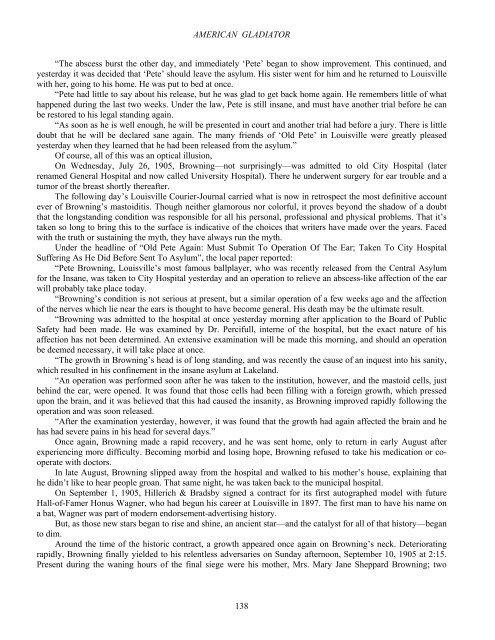AMERICAN GLADIATOR: The Life And Times Of ... - The Book Locker
AMERICAN GLADIATOR: The Life And Times Of ... - The Book Locker
AMERICAN GLADIATOR: The Life And Times Of ... - The Book Locker
Create successful ePaper yourself
Turn your PDF publications into a flip-book with our unique Google optimized e-Paper software.
<strong>AMERICAN</strong> <strong>GLADIATOR</strong><br />
“<strong>The</strong> abscess burst the other day, and immediately ‘Pete’ began to show improvement. This continued, and<br />
yesterday it was decided that ‘Pete’ should leave the asylum. His sister went for him and he returned to Louisville<br />
with her, going to his home. He was put to bed at once.<br />
“Pete had little to say about his release, but he was glad to get back home again. He remembers little of what<br />
happened during the last two weeks. Under the law, Pete is still insane, and must have another trial before he can<br />
be restored to his legal standing again.<br />
“As soon as he is well enough, he will be presented in court and another trial had before a jury. <strong>The</strong>re is little<br />
doubt that he will be declared sane again. <strong>The</strong> many friends of ‘Old Pete’ in Louisville were greatly pleased<br />
yesterday when they learned that he had been released from the asylum.”<br />
<strong>Of</strong> course, all of this was an optical illusion,<br />
On Wednesday, July 26, 1905, Browning—not surprisingly—was admitted to old City Hospital (later<br />
renamed General Hospital and now called University Hospital). <strong>The</strong>re he underwent surgery for ear trouble and a<br />
tumor of the breast shortly thereafter.<br />
<strong>The</strong> following day’s Louisville Courier-Journal carried what is now in retrospect the most definitive account<br />
ever of Browning’s mastoiditis. Though neither glamorous nor colorful, it proves beyond the shadow of a doubt<br />
that the longstanding condition was responsible for all his personal, professional and physical problems. That it’s<br />
taken so long to bring this to the surface is indicative of the choices that writers have made over the years. Faced<br />
with the truth or sustaining the myth, they have always run the myth.<br />
Under the headline of “Old Pete Again: Must Submit To Operation <strong>Of</strong> <strong>The</strong> Ear; Taken To City Hospital<br />
Suffering As He Did Before Sent To Asylum”, the local paper reported:<br />
“Pete Browning, Louisville’s most famous ballplayer, who was recently released from the Central Asylum<br />
for the Insane, was taken to City Hospital yesterday and an operation to relieve an abscess-like affection of the ear<br />
will probably take place today.<br />
“Browning’s condition is not serious at present, but a similar operation of a few weeks ago and the affection<br />
of the nerves which lie near the ears is thought to have become general. His death may be the ultimate result.<br />
“Browning was admitted to the hospital at once yesterday morning after application to the Board of Public<br />
Safety had been made. He was examined by Dr. Percifull, interne of the hospital, but the exact nature of his<br />
affection has not been determined. An extensive examination will be made this morning, and should an operation<br />
be deemed necessary, it will take place at once.<br />
“<strong>The</strong> growth in Browning’s head is of long standing, and was recently the cause of an inquest into his sanity,<br />
which resulted in his confinement in the insane asylum at Lakeland.<br />
“An operation was performed soon after he was taken to the institution, however, and the mastoid cells, just<br />
behind the ear, were opened. It was found that those cells had been filling with a foreign growth, which pressed<br />
upon the brain, and it was believed that this had caused the insanity, as Browning improved rapidly following the<br />
operation and was soon released.<br />
“After the examination yesterday, however, it was found that the growth had again affected the brain and he<br />
has had severe pains in his head for several days.”<br />
Once again, Browning made a rapid recovery, and he was sent home, only to return in early August after<br />
experiencing more difficulty. Becoming morbid and losing hope, Browning refused to take his medication or cooperate<br />
with doctors.<br />
In late August, Browning slipped away from the hospital and walked to his mother’s house, explaining that<br />
he didn’t like to hear people groan. That same night, he was taken back to the municipal hospital.<br />
On September 1, 1905, Hillerich & Bradsby signed a contract for its first autographed model with future<br />
Hall-of-Famer Honus Wagner, who had begun his career at Louisville in 1897. <strong>The</strong> first man to have his name on<br />
a bat, Wagner was part of modern endorsement-advertising history.<br />
But, as those new stars began to rise and shine, an ancient star—and the catalyst for all of that history—began<br />
to dim.<br />
Around the time of the historic contract, a growth appeared once again on Browning’s neck. Deteriorating<br />
rapidly, Browning finally yielded to his relentless adversaries on Sunday afternoon, September 10, 1905 at 2:15.<br />
Present during the waning hours of the final siege were his mother, Mrs. Mary Jane Sheppard Browning; two<br />
138
















